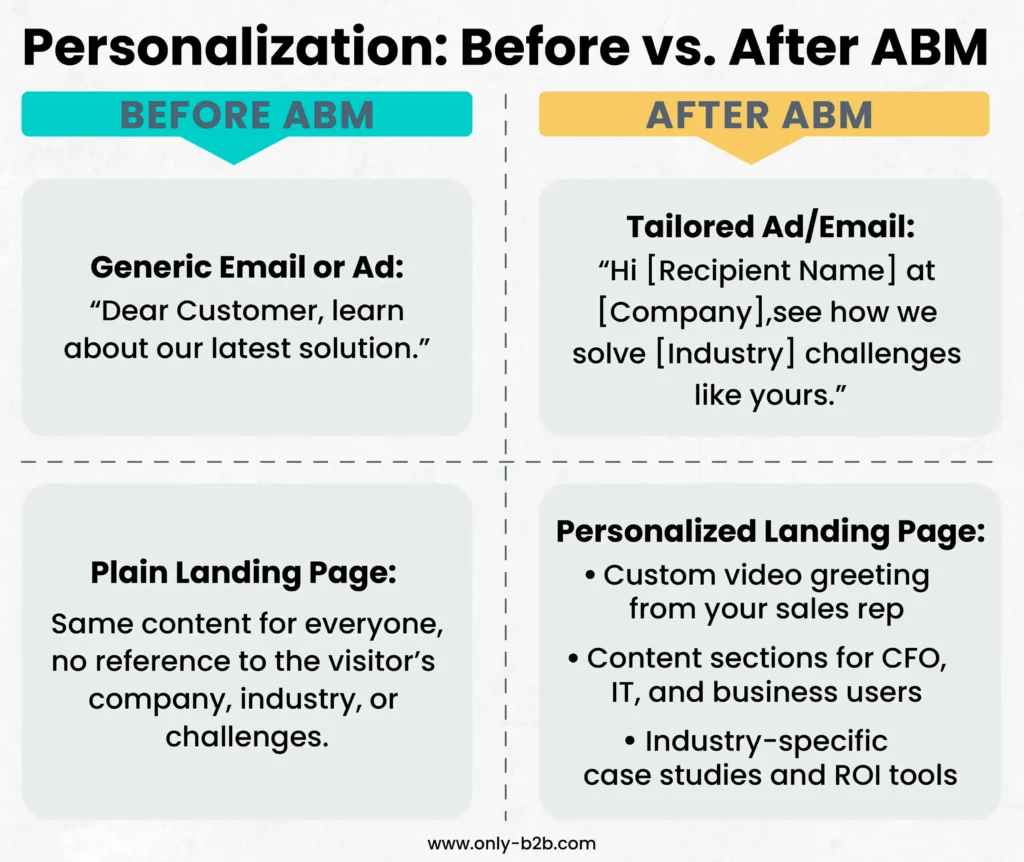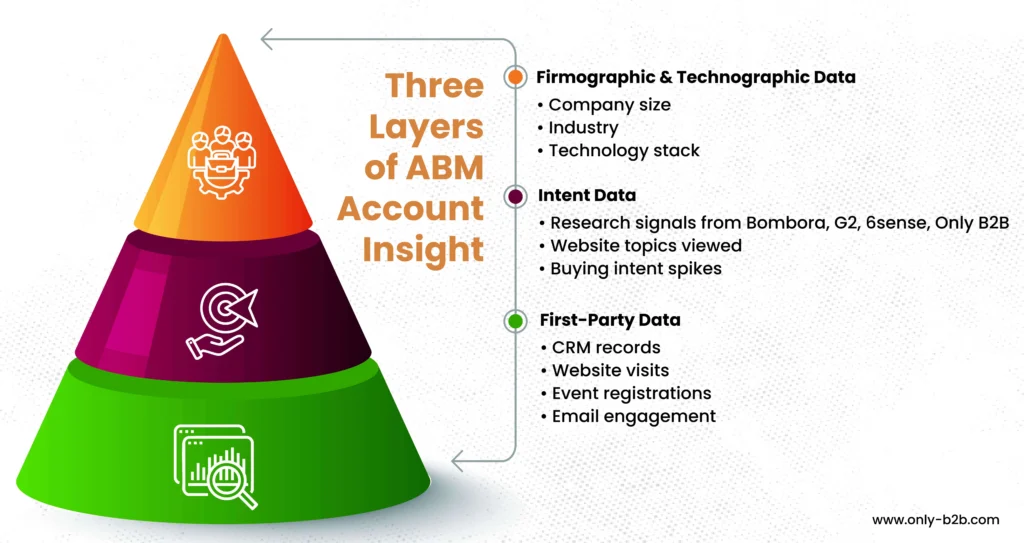When too many cooks are involved in the kitchen, nobody takes full ownership, and the decision drags on. You never get the perfect dish.
It’s the same in B2B sales. When too many decision-makers (6 to 10) are involved, each with their own priorities, pain points, and timelines, decisions stall.
Will increasing ad impressions or sending more email reminders push these deals forward? Not really. These ABM tactics deliver shallow engagement and little influence on actual purchase decisions.
But what if you had a framework-driven approach to ABM retargeting that could cut your sales cycles by 30%?
This blog is all about that. We will break down a proven five-stage framework for ABM retargeting to unlock more pipeline, nurture buying groups, and get to “yes” faster.
ABM Retargeting vs. Traditional Retargeting
Table of Contents
What’s retargeting? Is it just about reaching previous website visitors or recycling contacts with generic ads?
In reality, such traditional retargeting fails for several reasons, such as:
- It focuses on individuals, not the entire account or committee.
- It treats every buyer the same, ignoring their role or stage in the journey.
- It relies on surface-level data, missing crucial buying signals hidden deep within organizations.
ABM retargeting means pulling engagement threads across all stakeholders, using intent signals and real-time data to personalize messaging and channel mix. However, integrating multiple sources, CRM, intent platforms, and sales data is challenging.

Companies using a mature ABM strategy report up to a 30% faster sales cycle compared to those using traditional lead-based marketing (Demandbase, 2024)
The 5-Stage ABM Retargeting Framework
Here’s how you address the true blockers and accelerate complex deals:
Stage 1: Account Discovery & Intent Identification
It’s easy to get excited about a new inbound lead coming through, maybe it’s a well-written demo request or a whitepaper download.
Yes, they are important, but they can be misleading. For example, you might chase a hot lead for weeks, only to discover that the contact was just curious, not a real decision-maker.
Or worse, you find out later that the rest of the buying committee never even heard about your solution.
The truth is, a single inbound lead is just the tip of the iceberg. What really matters is whether the full account is aligned, interested, and actively moving toward a decision.
This requires you to activate all available data, syncing CRM, web, and event data for a real-time view, and using intent data platforms like Bombora or 6sense to monitor for intent.
Keep an eye on spikes in activity, such as multiple contacts engaging with high-value content or competitor comparisons.
Rather than treating every engaged company equally, prioritize those showing buying intent. Intent doesn’t mean any engagement, but patterns that signal a team is assembling internally to solve a problem.
This saves you from spreading your retargeting budget too thin.
Stage 2: Awareness & Problem Agitation
It’s tempting to share product features with everyone on your target list and hope someone will bite. But in reality, most buyers at this stage aren’t ready for solutions. Your job is to make them realize the urgency of their problem.
However, breaking through isn’t easy. You need relevant, multi-channel campaigns that highlight the risks of inaction. Think of:
- Using LinkedIn for executives
- Display ads for awareness
- Direct mail for impact
- Targeted email for known leads
Again, make sure your content is customized with industry-specific pain points. What matters to a SaaS CFO is different from what matters to a retail CIO.
Don’t jump straight to the product. Instead, focus on making your brand the expert and sparking internal discussions at your target accounts.
Stage 3: Solution Education & Comparison
“Feature dumping” is a deadly trap. More information will not necessarily move the deal. It can stall it. We all know buyers are busy comparing multiple vendors. Yet marketers often share generic content, adding confusion.
Focus on differentiation and business value by:
- Using interactive ROI calculators
- Sharing peer benchmarks
- Showcasing success stories
Additionally, provide stakeholders with tools to visualize their specific gains. Consider sharing competitive battlecards or analyst reports when buyers are actively comparing options. Don’t assume your value is obvious.
Deals stall not from lack of content, but from lack of clarity and consensus on why you’re the best choice.
Example:
A cloud software vendor sends a series of emails, “Why Us vs. Competitor X,” invites the account to a live demo, and uses ads promoting a “See Your ROI” calculator.
Stage 4: Stakeholder Expansion & Consensus Building
If you win over a single key champion, is the deal secure? Definitely not. In reality, your deal is tied to multiple stakeholders, and one thread won’t secure it.
And single-threading stalls deals because it won’t reveal hidden stakeholders’ objections, or new decision-makers joining late in the game.
Map the full buying committee and deliver role-specific, relevant content:
- Compliance guides for legal
- ROI models for finance
- Technical briefs for IT
Equip your internal champions with resources, FAQs, executive decks, and playbooks. This will help you drive consensus across the organization. And once you personalize outreach to each function, you remove roadblocks and ensure no stakeholder is left out.
Example:
A martech provider builds a “Champion Toolkit” landing page for key advocates and runs segmented retargeting ads for IT, marketing, and procurement, each addressing their top priorities.
Stage 5: Decision Acceleration & Closing Support
It’s easy to think that an end-of-quarter discount or a flurry of closing emails will nudge the deal over the finish line. But in B2B sales, uncertainty and risk aversion slow decisions at the last mile.
Instead, provide targeted support like:
- Limited-time offers
- Executive briefings
- References to address late-stage objections
Be sure your outreach is personalized, from your leadership to your buyer’s C-suite. Enable your sales team with real-time insights so their follow-up is precise, not generic.
The key is to make the value of moving forward now feel greater than the perceived risk of waiting, without coming off as desperate.
Example:
When a deal stalls, a software company sends a note from the CEO to the prospect’s CMO, invites the committee to an “Executive Q&A,” and offers a reference call with a happy customer.

Technology Stack & Implementation
Technology alone will not fix broken ABM programs. Instead, the best tools need to be connected and aligned for real results.
Only B2B focuses on integrating your ABM platform, like 6sense, Demandbase, Terminus, or RollWorks, with your CRM, such as Salesforce, HubSpot, or Microsoft Dynamics, and analytics solutions like Bizible or LeanData.
Without this integration, you risk running fragmented campaigns and missing out on critical insights that could improve performance.
Optimization & Measurement
Great ABM teams know that “set it and forget it” is a myth. Testing and optimization keep you going. Focus on KPIs that actually matter, such as pipeline acceleration, account engagement, and influenced revenue, not just ad clicks or open rates.
Perform A/B testing, rotate messaging every 6-8 weeks, and reallocate budget to high-performing channels. Regular campaign reviews with both sales and marketing ensure you’re not optimizing in a vacuum.
Conclusion
Long, complex sales cycles are a hard reality of B2B. But a crowded kitchen needs a clear recipe and coordinated effort to keep momentum strong.
By adopting a five-stage ABM retargeting framework, you can keep your brand front and center, influence every stakeholder, and shorten the path to “closed-won.” In fact, account based sales strategies complement ABM retargeting perfectly, ensuring every touchpoint is aligned with high-value accounts.
More activity does not equal more progress. Success lies in strategic, relevant engagement across the right channels, to the right people, at the right time.
If you’re ready to cut your sales cycle by 30%, start mapping your ABM retargeting plan today and equip your team to win more deals, faster.

Vikas Bhatt is the Co-Founder of ONLY B2B, a premium B2B lead generation company that specializes in helping businesses achieve their growth objectives through targeted marketing & sales campaigns. With 10+ years of experience in the industry, Vikas has a deep understanding of the challenges faced by businesses today and has developed a unique approach to lead generation that has helped clients across a range of industries around the globe. As a thought leader in the B2B marketing community, ONLY B2B specializes in demand generation, content syndication, database services and more.





